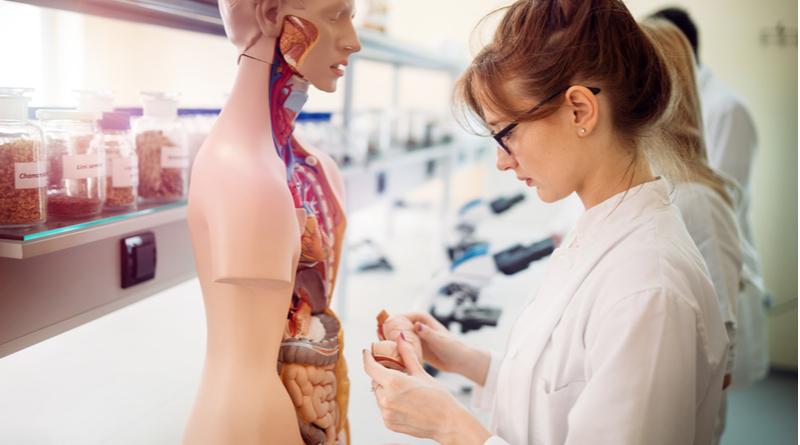What is Human Anatomy?
Human anatomy is the study, identification, and description of the structures of the human body. An understanding of anatomy is very important to the practice of medicine and other areas of health.
Human anatomy includes the appearance and position of the various parts of the human body, the materials from which they are composed, their locations, and their relationships with other parts. Anatomy is quite distinct from physiology and biochemistry, which deal respectively with the functions of those parts and the chemical processes involved.
What 3rd level courses are available?
Universities and colleges in Ireland are offering Human Anatomy courses in the following subject areas:
- Diploma In Anatomy And Physiology Of Human Body – An introduction to the medical world and overview of anatomy and physiology.
- Anatomy & Physiology (QQI Level 5) – Gain the knowledge, skill, and competence to understand the structure and function of the human body.
- ITEC Reflexology Diploma Inc. Anatomy & Physiology – Our reflexology training course is intended for those who wish to gain a recognized professional Irish qualification and internationally recognized qualification (ITEC) to practice in Ireland and around the world as a professional reflexologist.
- Occupational Therapy Studies – Gain an insight into the development and implementation of therapeutic programs in occupational therapy.
- Certificate in Occupational Therapy Essentials -This course will teach you to help people accept their current conditions, learn how to live with them, and move forward to lead happier and healthier lives.
Studying Human Anatomy in college
Many Human Anatomy courses take place over 1 year to 4 years depending on the course and modules selected. There are also part-time courses and night courses available so you can be sure to fit in your studies no matter what your schedule is like.
Courses will cover theory work through lectures, assignments, tutorials, and taught modules. Assessments will take place continuously with written examinations and practical assignments combined to achieve a qualification.
You could also consider work experience or volunteering to help in a caring or healthy environment. This is to show that you have an understanding of what working in fields that deal with human anatomy is like and that you appreciate the emotional and physical demands, as well as the skills required.
You could also improve your skills by undertaking voluntary work at clinics or hospitals or finding relevant work experience in hospitals and GP practices, hospices and care homes, or any other environment that involves caring for people. If possible, try to get experience that involves contact with patients and doctors or other healthcare professionals.
Work Experience will not only allow you to obtain a deeper knowledge and understanding of the industry, but it will also give you a chance to do some essential networking with other industry professionals and gain valuable contacts for the future
Career options
After completing a course in Human Anatomy you will be able to get started in a career that uses specific knowledge of human anatomy and physiology.
Typical employers within the Human Anatomy field are GP surgeries, hospitals, health centers, psychiatry services, and rehabilitation facilities. Your progression and development in your chosen profession will depend on your increasing knowledge of specialties and general medical knowledge.
With experience and further training, you may become established in one particular health field but must retain a broad medical knowledge. This ensures that you are up to date and can contribute generalist knowledge to highly specialized teams. Your broad medical knowledge also gives better career flexibility through the ability to switch between specialties. Areas of specialty may include mental health or pediatric care.
Working hours will depend on whether you are employed by a company with set business hours or if you are contracted to various facilities or companies and will vary greatly depending on the position or career you choose. Typically within the health care field working hours can vary and you’ll be expected to be flexible. You may be required to work shifts, which can include out of hours, nights, and weekends.
Expect to work long and sometimes unsocial hours, although working hours vary according to specialty. Many roles involve being on-call for certain periods.
Related jobs include:
There are many related jobs that all need knowledge of anatomy, such as:
- Medical doctor
- Hospital doctor
- Adult nurse
- Children’s nurse
- Clinical scientist, genomics
- Epidemiologist
- Higher education lecturer
- International aid/development worker
- Medical sales representative
- Medical science liaison
- Mental health nurse
- Midwife
- Naturopath
- Paramedic
- Physician associate
- Biological scientist
- Research scientist
- Science writer
- Anesthetist
- Cardiologist
- Clinical radiologist
- Neurologist
- Ophthalmologist
- Pathologist
- Psychiatrist
- Surgeon
- Physical therapist
- Occupational therapist
Further study
After completing a course in Human Anatomy you may choose to pursue further study in a specialist field to increase your knowledge base and skillset. Postgraduate study can also be used as a means to change career focus or to gain professional qualifications required to practice in certain career areas such as teaching or scientific research, journalism, or management.
FAQ
Why is studying Human Anatomy important?
The study of Human Anatomy provides basic knowledge about the human body and how our bodies function which in turn helps to indicate to healthcare professionals when something is not working the way it should.
What are the major systems of the body?
There are 11 organ systems in the human body:
· the skeletal system
· the muscular system
· the lymphatic system
· the respiratory system
· the digestive system
· the nervous system, including the central and autonomic systems
· the endocrine system, which regulates hormone production
· the cardiovascular system, including the heart
· the urinary system
· the reproductive system
· the integumentary system, which includes the skin, hair, and nails, among other areas
· These systems all work together and depend on each other to function.
Where can I study Human Anatomy?
Explore your options here
Did You Know?
· Infants are born with approximately 300 bones, but as they grow some of these bones fuses. By the time they reach adulthood, they only have 206 bones.
· There are anywhere between 60,000-100,000 miles of blood vessels in the human body. If they were taken out and laid end-to-end, they would be long enough to travel around the world more than three times.
· Teeth are considered part of the skeletal system but are not counted as bones.
· Earwax is a type of sweat. Ear wax is a combination of dead skin cells, sebum, and various waxes the ceruminous glands produce. Ceruminous glands are a specialized sweat gland
· The average nose produces about a cupful of nasal mucus every day.












Comments